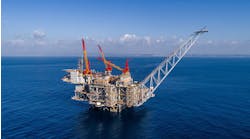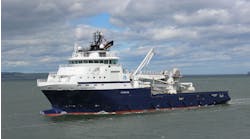SURVEYS/SEABED TECHNOLOGY: Historical relics not uncommon discovery during E&D bottom surveys
Archeological discoveries during site surveys preparatory to oil and gas exploration and development (E&D) operations are not rare events in the world's oceans and bays. Increasingly, maritime countries are asking for identification and recovery, if possible, of sunken relics and vessels. Some relics are quite large or in such bad shape, they cannot be recovered, and most vessels are out of the question. But the identification of the vessels and relics assists archeologists in determining the course and fate of naval action at sea as well as seafaring history.
During World War II, about 20 German submarines were routinely assigned to harrass and sink ships in the Gulf of Mexico, with some success. The clear naval objective, from the German point of view, was to stop the movement of crude oil from Texas and Louisiana to eastern refineries, and choking off the war effort.
According to the US Minerals Management Service (MMS), which is charged with identification of sunken artifacts, the 20 submarines were believed to have sunk 56 vessels, of which 12 have been located. The German submarines roamed the Gulf of Mexico freely during 1942 and 1943, actively disrupting the flow of oil carried by tankers from Texas and Louisiana ports, according to the MMS monograph. However, the U-boat attacks became increasingly rare by the end of 1943, for two reasons:
- Merchant vessels began cruising in armed convoys
- The "Big Inch" pipeline from Texas to New Jersey came onstream, allowing the movement of oil overland.
U-166 incident
One of the 20 submarines, the U-166, after successfully torpedoing and sinking the passenger freighter SS Robert E. Lee, was itself sunk by a depth charge. The charge was believed to have come from the freighter's escort. The U-166 was the only submarine sunk in the Gulf of Mexico, and ironically, lies within one mile of the vessel it sunk.
The submarine came to rest in a crater in over 5,000 ft water depths, 45 miles off the mouth of the Mississippi River. The MMS says the vessel has been the object of an extensive search over the Gulf of Mexico for 59 years. The U-boat's whereabouts had long been disputed, and it was thought to lie far from its actual resting-place, according to an MMS statement.
The commencement of a bottom survey by BP and Shell for the possible installation of a deepwater pipeline was the opportunity to uncover seafloor side-scan radar data that could be used to pinpoint sunken vessels. BP and Shell agreed to expand the seafloor search to assist in the evaluation.
The gas pipeline survey employed a high-tech, mini-submarine, remote-sensing instrument developed by C&C Technologies, Inc. of Lafayette, Louisiana, not used previously in the Gulf of Mexico, according to the MMS.
"It is unlikely that this discovery, or many others that have been made in the waters of the Outer Continental Shelf, would have occurred without the regulation and oversight of MMS. As a result of this important discovery, BP and Shell have re-routed their proposed pipeline around the site, a standard means of preserving historic sites from harm during construction."
Seabed surveys
An MMS statement says the agency considers the effect of its lease sales, studies, and permits on the cultural heritage of the US. Thus, it requires the oil and gas industry to conduct marine remote-sensing surveys that may identify shipwrecks. "The MMS has staff archeologists trained to review the geophysical reports submitted by the oil and gas industry. As a result, when BP and Shell first realized the significance of what they had discovered, their first report was made to MMS for direction on how to proceed," said Gulf of Mexico Regional Director Chris Oynes.
"In this particular instance, Shell and BP were only required by our regulations to investigate the narrow corridor that would be directly affected by their project, which is well clear of both vessels. It is only because of their commitment to go above and beyond the basic requirements that we could solve this 59-year-old mystery and ensure the protection of these vessels. Taken together, these ships are a powerful monument to the memory of the sacrifices made by both sides during the Second World War."
MMS archeologists accompanied BP and Shell personnel and their own contract archeologists from C&C Technologies on a research mission for the first glimpse of the U-boat by using a camera aboard a remotely operated vehicle. The MMS says it reviews about 1,700 well and pipeline plans every year for their effect on archeological sites in the Gulf of Mexico, and "more than 100 shipwrecks have been discovered on the floor of the Gulf of Mexico.
"While many of the wrecks are either local fishing or shrimp boats, crewboats, and other modern vessels, over a dozen World War II casualties of the six U-boats known to have patrolled the Gulf, have been found. Older shipwrecks have also been identified and studied, including the passenger steamer New York, sunk in 1846, and the Civil War Union gunboat USS Hatteras. Last year, the MMS listed the well-preserved side-wheel steamer Josephine to the National Register of Historic Places, an official list maintained by the federal government of the nation's most important historical sites."
Other history
A total of 400 vessels have sunk in US Gulf of Mexico federal waters since 1625, according to an MMS historical web site. Thousands more have sunk in state waters (Florida, Alabama, Miss- issippi, Louisiana, and Texas), but these are largely unrecorded. "Over 70 vessels are believed to have wrecked on the OCS between the beginning of the 19th century and start of the Civil War in 1861, the website monograph related."
"One of the most historically significant of these is the wreck of the New York, a side-wheel steamship engaged in trade between Galveston, New Orleans, and New York from 1839 to her loss in 1846. The wreck site was recently discovered by commercial salvers who are cooperating fully with the MMS to preserve the site's archeological information and to ensure that it is not impacted by future oil and gas development."
Only one US warship dating back to the US Civil War (1861-1865), however, was sunk at sea in the Gulf of Mexico, according to the website monograph.
"The USS Hatteras today rests in 58 ft of water about 20 miles off Galveston," the website monograph states. "Her 210-ft long iron hull is completely buried under about 3 ft of sand. Only the remains of her 500-hp walking beam steam engine and her two iron paddle wheels remain exposed above the seafloor. Since the site's discovery in the 1970s, MMS has engaged in periodic monitoring of the wreck to ensure that it is not damaged by surrounding oil and gas lease development."


